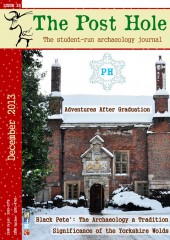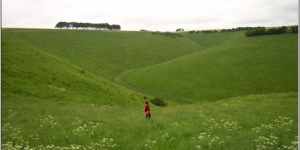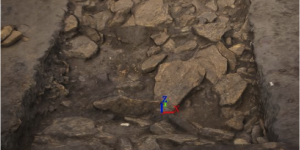The practical approaches of major archaeological investigations towards deserted medieval villages have included aerial photography and Ordnance Survey maps that have recorded many sites (Hoskins 1973, 7; Taylor 2010, 6). The landscape of these deserted medieval villages includes the parish and the interaction between settlements (Stamper 2009, 331; Winchester 2000). The history of theoretical approaches towards these sites began with old fashioned ideas about the Black Death causing these villages to become deserted (Beresford and Hurst 1990, 27; Dyer 2010, 29; Stamper 2011, 5; Whittock 2009, 47). This was replaced after the Second World War by accurate explanations of how sheep pasture and expanding country house estates caused village desertion (Dyer 2010, 28). This change was a result of fresher approaches as well as medieval archaeology becoming its own discipline (Stamper 2011, 5). Deserted medieval villages have a wider importance in medieval archaeology as they played an important part in shaping medieval England’s landscape economically, socially, militarily, and politically (Roberts and Wrathmell 2002, 150). Although Wharram Percy is the most excavated and studied deserted medieval village (Fenton–Thomas 2005, 23; Pryor 2011, 347; Wrathmell 2010, 109), it is important to study each site’s attributes individually, to broaden the study of these sites. This is why further research of deserted medieval villages is necessary to fully understand each site in relation to recent approaches (Dyer and Jones 2010; Rowley and Wood 2000). Eastern Yorkshire is important to this study because there are a lot of deserted medieval villages in this area of England, which includes Wharram Percy (Beresford and Hurst 1990, 13–5; Fenton–Thomas 2005, 23, 116; Hoskins 1977, 118; Wrathmell 2010, 109). The Harrying of the North in 1069–70 took place in east Yorkshire, meaning there is clearer evidence of redeveloped village plans (Richards 2001; Sheppard 1976, 9–10; Stamper 2011, 5).
Before World War Two, there was not much interest in deserted medieval villages as academics focused on documentary evidence and standing stone buildings which tended to represent the wealthy and elite, but since the 1950s, deserted medieval villages have been studied more appropriately (Beresford and Hurst 1989, 76; Crabtree 2009). After World War Two deserted medieval villages started to gain greater academic interest, especially through the Wharram Percy excavations (Crabtree 2009, 880; Gerrard 2003, 103). Before 1950, scholars misinterpreted the Black Death, as causing deserted medieval villages, because of the depopulation and some villages’ failure to recover from this (Beresford and Hurst 1990, 27; Hoskins 1977, 120; Rowley and Wood 2000, 14–6; Whittock 2009, 47). Key contributors to the study of deserted medieval villages, such as William Hoskins and Maurice Beresford, disproved this by stating that deserted medieval villages were caused by agricultural changes and land redistribution (Taylor 2010, 4). Beresford, Hoskins and other influential individuals managed to change perceptions of deserted medieval villages (Taylor 2010, 4).
Beresford excavated at Wharram Percy alongside John Hurst (Beresford and Hurst 1990; Crabtree 2009, 881; Stamper 2009, 332–3), and then later Stuart Wrathmell excavated there in the 1980s, discovering that peasant longhouses were constantly altered throughout every generation (Beresford and Hurst 1989, 85; Stamper 2009, 333). Modern perspectives on deserted medieval villages include the focus on surviving villages, viewing deserted medieval villages from the peasant’s perspective and questioning the term ‘deserted medieval village’ itself (Jones 2010, 8–12; Smith 2010, 64). The term ‘deserted medieval village’ may also refer to a hamlet, shrunken village or a relocated village, since there was a varying degree of desertion amongst the sites analysed (Jones and Page 2006, 10). As not all sites are fully abandoned, most sites have non–medieval phases and it is difficult to distinguish between townships, villages, hamlets and large farmstead arrangements (Jones 2010, 11–2). Some settlements were only relocated or shrunk, depending on the decisions of the landlords (Fenton–Thomas 2005; Jones 2010; Rowley and Wood 2000). Village desertion across the country is mainly the result of sheep pasture and expanding estates (Dyer 2010, 29; Hoskins 1973, 65; Williamson 2010, 180). Most settlements still show the original planned layout from the Norman period; however it is likely that most sites will have an Anglo–Scandinavian influence (Gies and Gies 1991; Whittock 2009). In Holderness, environmental conditions such as coastline erosion, meres and marshes also led to village abandonment (Beresford and Hurst 1989, 54; Jones 2010, 21).
Deserted medieval villages show the lifestyle of ordinary peasants (Wrathmell 1996, 11), unlike the studies of pre–1950s antiquarians who were more concerned with important people and buildings (Beresford and Hurst 1989, 76). The lack of above ground remains of deserted medieval villages, as well as few medieval peasants rarely leave behind written accounts, contributed to this (Gies and Gies, 1991: 5). Most medieval peasants were not literate and accounts of medieval peasants tended to be written from those with more wealth and power (Gies and Gies 1991, 5). Deserted medieval village buildings tended to be made from perishable materials, mainly wood, whereas stone built buildings were likely to survive and were considered a status building material in the medieval period (Beresford and Hurst 1989, 93; Beresford and Hurst 1990, 38; Wrathmell 1996, 13).
Aerial photography highlights the village layout, shown through remaining earthworks where buildings used to stand, trackways and boundaries which are not as obvious on foot (Beresford 1951, 130; Beresford and Hurst 1990, 18–9; Gies and Gies 1991, 4–5). Ordnance Survey maps, which have been commissioned since the early nineteenth century, are good at recording the locations of deserted medieval villages (Beresford 1951; Richards 2001; Taylor 2010). The East Riding of Yorkshire in particular was fortunate enough to be recorded by Captain John Bayly, who had a fond interest in antiquity and recorded as many deserted medieval villages as possible (Beresford 1992, 65–6; Taylor 2010, 2). Aerial photography and Ordnance Survey maps are both useful at quickly recording (Beresford and Hurst 1990; Hoskins 1973; Taylor 2010) since the landscape is being recorded rather than a specific area, and research can be initiated from them. On most deserted medieval village excavations trenching is popular; Wharram Percy pioneered total area excavation as this technique became popular, enabling an area to be fully excavated (Beresford and Hurst 1989, 83; Ralston and Hunter 2009, 8). Wharram Percy became a predominant site for medieval rural archaeology, with the lives of ordinary peasants being the focus of attention unlike pre–1950s interest in medieval antiquity (Stamper 2009, 332–3).
Most deserted medieval villages have been aerially photographed, and in more recent times, deserted medieval villages can be seen from above by using Google Earth’s satellite imagery (Kaimaris et al. 2011, 268–9). Alongside Ordnance Survey data, this makes it easier to identify deserted medieval villages and to locate them (Taylor 2010, 6). These constitute principal pre–excavation research because they indicate where a deserted medieval village is within its landscape (Beresford and Hurst 1990). As it is cheap and easy to use the combined resources of Google Earth and Ordnance Survey mapping, they are used in the first phases of investigation (Beresford 1992; Kaimaris et al. 2011).
Aerial photographs and Ordnance Survey maps show trackways between places that can be traced over long distances (Beresford 1951, 130). Since Ordnance Survey maps and aerial photography are good at recording long distances they can show this better than other types of evidence, and they give a good visual aid to the whole landscape of a deserted medieval village (Taylor 2010). They can clearly depict these features (Beresford 1992), for example, the trackway between Wharram Percy and Thixendale shows where the villagers of Thixendale had to travel in order to get to St. Martin’s church at Wharram Percy (Beresford and Hurst 1990, 25, 101–2). Furthermore, parishes reveal how settlements close to one another were affected differently; an example of this can be found in the Wharram Percy parish, where Burdale, Raisthorpe, Thixendale, Towthorpe and Wharram Percy were all affected differently (Beresford and Hurst 1990, 129). Thixendale still survives as a village, Wharram Percy is completely abandoned and Burdale, Raisthorpe and Towthorpe were reduced to farmsteads, with the remains of the former village being visible in the earthworks (Beresford and Hurst 1990). Faunal and fauna evidence found at Wharram Percy (Mays 2004, 23) shows that there was medieval trade between coastal and inland centres, showing that rural sites were not isolated.
The remains of peasant longhouses and burials have revealed lifestyles (Wrathmell 1996, 11), with an osteological analysis of human remains revealing detailed information about peasant activities, diets, health, gender and age (Mays et al. 2001; Sofaer–Derevenski 2000). Artefacts found in peasant houses indicate the function of the buildings, their purposes and possibly the activities they carried out (Wrathmell 1996, 11). It is presumed that deserted medieval villages housed the vast majority of rural medieval England’s population (Dyer and Jones 2010; Whittock 2009). Since peasant farming occupied most of the land, this required a lot of labourers to farm it (Whittock 2009). The study of deserted medieval village populations and their living areas show how these societies interacted with their landscape (Wrathmell 1996), revealing which areas were ideal locations to place a settlement; areas were good for grazing animals, and areas that were good for growing crops (Carter 1995; Fenton–Thomas 2005; Muir 1997).
Village desertions started from the mid–fifteenth century, long after the Black Death (Dyer 1982, 19; Hoskins 1977, 123; Jones 2010, 22). Some villages were in long–term decline before the Black Death, some villages did not recover from it and some villages did recover or were unaffected but still were abandoned (Beresford and Hurst 1989, 8; Hoskins 1977, 120–3; Rowley and Wood 2000, 14–6). This is around the time when agriculture changed from peasant farming to sheep pasture and country house estates started to expand (Dyer 2010, 29; Gies and Gies 1991, 200; Hoskins 1977, 123, 163; Rowley and Wood 2000, 19). Sheep pasture was more profitable, due to the expanding textiles industry, and involved less responsibility with less people to look after (Beresford and Hurst 1989, 26). There are circumstances such as environmental conditions that also caused village desertion (Jones 2010, 21). In Holderness, villages such as Auburn were lost to the sea (Beresford and Hurst 1989, 54) and villages such as Eske and Southorpe were located on marsh or mere land that degenerated making the village unsustainable because of the unsuitability of the land (Beresford 1983, 393; Wrathmell 2012, 251). Sometimes, expanding urban centres meant the incorporation of deserted medieval villages into these areas, for example, Sewerby and Hilderthorpe both became incorporated into Bridlington (Beresford 1983, 21; Fenton–Thomas 2005, 69, 90; Rowley and Wood 2000, 28).
Despite the detailed excavations of Wharram Percy, no other deserted medieval village has been excavated to the same extent, which could be why other deserted medieval villages remain so unknown (Beresford and Hurst 1989). Excavations on other deserted medieval villages in eastern Yorkshire would indicate whether Wharram Percy was a typical deserted medieval village or whether it was unique, as every settlement has its own distinctive timeline (Beresford and Hurst 1990). Excavations on other deserted medieval villages would add depth to the study of medieval social, economic and political activities (Rowley and Wood 2000), demonstrating the diversity of each site and potentially displaying trends and patterns of deserted medieval villages.
Although most deserted medieval villages would have similarities to Wharram Percy, it is important to treat each site individually, as each village has its own past (Beresford and Hurst 1989). Modern surviving villages all have similarities and differences between them (Roberts 1987). Wharram Percy is unique in the fact that the manor estates were a continuation from Roman villas (Wrathmell 1996). Therefore, each deserted medieval village will have their own unique aspect to them.
Eastern Yorkshire has a high amount of deserted medieval villages compared to other areas of England and there are reasons for this (Beresford and Hurst 1990, 13–5; Fenton–Thomas 2005, 23, 116; Hoskins 1977, 118; Wrathmell 2010, 109). The Yorkshire Wolds were better suited to sheep pasture because of the chalky soils (Fenton–Thomas 2005, 56), plus land in this area was considered marginal for crop growth since the fifth century (Fenton–Thomas 2005, 81). The Howardian Hills had very rich landowners who wanted to expand their estates to show off their wealth and status, so villages were either removed or relocated out of convenience (Carter 1995). As a result of coastal erosion at Holderness, a mile’s worth of land has eroded since the Roman period (Jones 2010, 21; Muir 1997, 16) and the area has a lot of marshes and meres, which gradually made the land unsuitable for a village (Muir 1997).
Deserted medieval villages show the results of landownership, especially in terms of agriculture and attitudes of landlords and tenants (Dyer 2010, 29–30; Hoskins 1977, 123; Rowley and Wood 2000, 16–7). Most sites are linked to a manor house, monastic building, urban centre and sometimes, in the earlier medieval phases, deserted medieval villages had links with castles. This all stems from the Norman principal of ‘no land without a lord’ (Gies and Gies 1991, 28), although earlier Anglo–Saxon societies also had a similar structure (Gies and Gies, 1991; Whittock 2009). Initially, villagers once owed military services to their landlord, however over the centuries the military aspect was replaced by economic purposes (Gies and Gies 1991; Whittock 2009). Wealthy individuals, including those from urban areas and monasteries, also bought landholdings in villages (Beresford and Hurst 1990; Wrathmell 2010). Christopher Dyer (2010, 37) believes that deserted medieval villages represent the change from feudalism to capitalism, meaning that deserted medieval villages represent a significant change of ideology. This would reflect a significant shift as England gradually came out of the medieval period (Pryor 2011, 379).
Aerial photography and Ordnance Survey maps are the basis for which further excavation into deserted medieval villages can be undertaken (Hoskins 1973; Taylor 2010); alongside the literature, they show the wider landscapes of deserted medieval villages (Beresford 1983). These methods represent the first phases of research as well as conveying the spatial organisation of a deserted medieval village and its wider landscape. Further excavation will show intricate details about medieval village life, plus with the more recent approaches towards deserted medieval villages it would be interesting to see what the results would be (Dyer and Jones 2010)
Bibliography
- Beresford, M.W. (1951) ‘The Lost Villages of Medieval England’. The Geographical Journal. 117(2). 129–147
- Beresford, M.W. (1983) The Lost Villages of England. Gloucester: Alan Sutton
- Beresford, M. (1992) ‘The Spade Might Soon Determine It: the Representation of Deserted Medieval Villages on Ordnance Survey Plans, 1849–1910’. The Agricultural History Review. 40(1). 64–70
- Beresford, M.W. and Hurst, J.G. (1989) Deserted Medieval Villages. Gloucester: Alan Sutton
- Beresford, M. W. and Hurst, J.G. (1990) Wharram Percy: Deserted Medieval Village. London: B.T. Batsford
- Carter, A. (1995) Howardian Hills Mapping Project: A Report for the National Mapping Programme. Swindon: Royal Commission on the Historical Monuments of England/English Heritage
- Crabtree, P. (2009) ‘The Archaeology of Medieval Europe’. History Compass. 7(3). 879–893
- Dyer, C. (2010) ‘Villages in Crisis: Social Dislocation and Desertion 1370–1520’, in C. Dyer and R. Jones (Eds). Deserted Villages Revisited. Hatfield: University of Hertfordshire Press. 28–45
- Dyer, C. and Jones, R. (2010). Deserted Villages Revisited. Hatfield: University of Hertfordshire Press
- Fenton–Thomas, C. (2005) The Forgotten Landscapes of the Yorkshire Wolds. Stroud: Tempus
- Gerrard, C. (2003) Medieval Archaeology: Understanding Traditions and Contemporary Approaches. London: Routledge
- Gies, F. and Gies, J. (1991) Life in a Medieval Village. New York: Harper Perennial
- Hoskins, W.G. (1973) English Landscapes. London: British Broadcasting Corporation
- Hoskins, W.G. (1977) The Making of the English Landscape. London, etc.: Hodder and Stoughton
- Jones, R. (2010) ‘Contrasting Patterns of Village and Hamlet Desertion in England’, in C. Dyer and R. Jones (Eds). Deserted Villages Revisited. Hatfield: University of Hertfordshire Press. 8–27
- Jones, R. and Page, M. (2006) Medieval Villages in an English Landscape: Beginnings and Ends. Bollington: Windgather Press
- Kaimaris, D., Georgoula, O., Patias, P. and Stylianidis, E. (2011) ‘Comparative Analysis on the Archaeological Content of Imagery from Google Earth’. Journal of Cultural Heritage. 12. 263–269
- Mays, S. (2004) ‘Human Osteology at Wharram Percy: Life and Death in a Medieval Village’. Conservation Bulletin. Spring 2004. 22–23
- Mays, S., Taylor, G.M., Legge, A.J., Young, D.B. and Turner – Walker, G. (2001) ‘Paleopathological and Biomolecular Study of Tuberculosis in a Medieval Skeletal Collection from England’. American Journal of Physical Anthropology. 114. 298–311
- Muir, R. (1997) The Yorkshire Countryside: A Landscape History. Edinburgh: Keele University Press
- Pryor, F. (2011) The Making of the British Landscape. London: Penguin Books
- Ralston, I. and Hunter, J. (2009) ‘British Archaeology since the End of the Second World War’, in J. Hunter and I. Ralston (Eds). The Archaeology of Britain: An Introduction from Earliest Times to the Twenty – First Century. Second Edition. London: Routledge. 1–17
- Richards, J.D. (2001) ‘Anglian and Anglo–Scandinavian Cottam: Linking Digital Publication and Archive’. Internet Archaeology. 10. [Online]. Available at: http://intarch.ac.uk/journal/issue10/richards_index.html [Accessed 14th July 2013].
- Roberts, B.K. (1987) The Making of the English Village: A Study in Historical Geography. Harlow: Longman Scientific and Technical
- Roberts, B.K. and Wrathmell, S. (2002) Region and Place: A Study of English Rural Settlement. London: English Heritage
- Rowley, T. and Wood, J. (2000) Deserted Villages. Second Edition. Oxford: Shire Publications Ltd
- Sheppard, J.A. (1976) ‘Medieval Village Planning in Northern England: Some Evidence from Yorkshire’. Journal of Historical Geography. 2(1). 3–20
- Smith, S.V. (2010) ‘Houses and Communities: Archaeological Evidence for Variation in Medieval Experience’, in C. Dyer and R. Jones (Eds). Deserted Villages Revisited. Hatfield: University of Hertfordshire Press. 64–84
- Sofaer – Derevenski, J.R. (2000) ‘Sex Differences in Activity–Related Osseous Change in the Spine and the Gendered Division of Labour at Ensay and Wharram Percy, UK’. American Journal of Physical Anthropology. 111. 333–354
- Stamper, P. (2009) ‘Landscapes of the Middle Ages: Rural Settlement and Manors’, in J. Hunter and I. Ralston (Eds). The Archaeology of Britain: An Introduction from Earliest Times to the Twenty – First Century. Second Edition. London: Routledge. 328–347
- Stamper, P. (2011) ‘Introduction to Heritage Assets – Medieval Settlements’. English Heritage Guidelines/Standards. May 2011. 1–8
- Taylor, C. (2010) ‘The Origins and Development of Deserted Village Studies’, in C. Dyer and R. Jones (Eds). Deserted Villages Revisited. Hatfield: University of Hertfordshire Press. 1–7
- Whittock, M. (2009) Life in the Middle Ages. London: Robinson
- Williamson, T. (2010) ‘At Pleasure’s Lordly Call: the Archaeology of Emparked Settlements’, in C. Dyer and R. Jones (Eds). Deserted Villages Revisited. Hatfield: University of Hertfordshire Press. 162–181
- Winchester, A. (2000) Discovering Parish Boundaries. Second Edition. Oxford: Shire Publications Ltd
- Wrathmell, S. (1996) Wharram Percy: Deserted Medieval Village – English Heritage Guidebooks. London: English Heritage
- Wrathmell, S. (2010) ‘The Desertion of Wharram Percy Village and its Wider Context’, in C. Dyer and R. Jones (Eds). Deserted Villages Revisited. Hatfield: University of Hertfordshire Press. 109–120
- Wrathmell, S. (2012) ‘Northern England: Exploring the Character of Medieval Rural Settlements’, in N. Christie and P. Stamper (Eds). Medieval Rural Settlement: Britain and Ireland, AD 800 – 1600. Bollington: Windgather Press. 249–269








